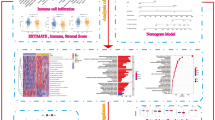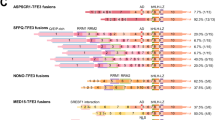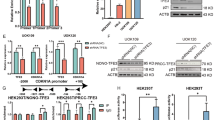Abstract
Transcription factor binding to IGHM enhancer 3-rearranged renal cell carcinoma (TFE3-RCC) is characterized by its aggressive nature, limited treatment options, and poor prognosis. However, the downstream targets of TFE3 fusion protein responsible for its tumorigenesis and progression remain unclear. Here, we demonstrated that leucine-rich repeat LGI family member 3 (LGI3) is a direct target of TFE3 fusion protein. TFE3 fusion protein can bind to the promoter of LGI3 and then activate its transcription. Importantly, LGI3 contributes to the proliferation, migration, and invasion of TFE3-RCC. Mechanistically, LGI3 interacts with gem nuclear organelle-associated protein 6 (GEMIN6) and inhibits its degradation via decreasing its ubiquitination. GEMIN6 upregulation promotes the mRNA maturation of Aurora B kinase (AURKB), thereby promoting the progression of TFE3-RCC. Importantly, drugs targeting GEMIN6 or AURKB significantly suppressed the growth of TFE3-RCC cells and organoids. In human TFE3-RCC tissues, LGI3 is highly expressed and positively correlated with GEMIN6 and AURKB. Overall, we revealed a novel mechanism underlying the progression of TFE3-RCC and provided potential new therapeutic targets.
This is a preview of subscription content, access via your institution
Access options
Subscribe to this journal
Receive 50 print issues and online access
$259.00 per year
only $5.18 per issue
Buy this article
- Purchase on SpringerLink
- Instant access to full article PDF
Prices may be subject to local taxes which are calculated during checkout







Similar content being viewed by others
Data availability
The TCGA data was downloaded from the Genomics Data Commons portal of the National Cancer Institute(https://portal.gdc.cancer.gov/). Data of the West China Hospital was downloaded from the GEO with the identifier GSE167573. Data of Dana-Farber Cancer Institute was downloaded from the GEO with the identifier GSE188885. The transcriptome sequencing data is available via NCBI (https://www.ncbi.nlm.nih.gov/sra/PRJNA1241189). The LC-MS data is available via ProteomeXchange with the identifier PXD061623.
References
Hsieh JJ, Purdue MP, Signoretti S, Swanton C, Albiges L, Schmidinger M, et al. Renal cell carcinoma. Nat Rev Dis Prim. 2017;3:17009.
Martínez Chanzá N, Xie W, Asim Bilen M, Dzimitrowicz H, Burkart J, Geynisman DM, et al. Cabozantinib in advanced non-clear-cell renal cell carcinoma: a multicentre, retrospective, cohort study. Lancet Oncol. 2019;20:581–90.
Kauffman EC, Ricketts CJ, Rais-Bahrami S, Yang Y, Merino MJ, Bottaro DP, et al. Molecular genetics and cellular features of TFE3 and TFEB fusion kidney cancers. Nat Rev Urol. 2014;11:465–75.
Bakouny Z, Sadagopan A, Ravi P, Metaferia NY, Li J, AbuHammad S, et al. Integrative clinical and molecular characterization of translocation renal cell carcinoma. Cell Rep. 2022;38:110190.
Magers MJ, Udager AM, Mehra R. MiT family translocation-associated renal cell carcinoma: a contemporary update with emphasis on morphologic, immunophenotypic, and molecular mimics. Arch Pathol Lab Med. 2015;139:1224–33.
Chang IW, Huang HY, Sung MT. Melanotic Xp11 translocation renal cancer: a case with PSF-TFE3 gene fusion and up-regulation of melanogenetic transcripts. Am J Surg Pathol. 2009;33:1894–901.
Motyckova G, Weilbaecher KN, Horstmann M, Rieman DJ, Fisher DZ, Fisher DE. Linking osteopetrosis and pycnodysostosis: regulation of cathepsin K expression by the microphthalmia transcription factor family. Proc Natl Acad Sci USA. 2001;98:5798–803.
Wang XM, Zhang Y, Mannan R, Skala SL, Rangaswamy R, Chinnaiyan A, et al. TRIM63 is a sensitive and specific biomarker for MiT family aberration-associated renal cell carcinoma. Mod Pathol. 2021;34:1596–607.
Baba M, Furuya M, Motoshima T, Lang M, Funasaki S, Ma W, et al. TFE3 Xp11.2 translocation renal cell carcinoma mouse model reveals novel therapeutic targets and identifies GPNMB as a diagnostic marker for human disease. Mol Cancer Res. 2019;17:1613–26.
Feng H, Cao S, Fu S, Liu J, Gao Y, Dong Z, et al. NMRK2 is an efficient diagnostic indicator for Xp11.2 translocation renal cell carcinoma. J Pathol. 2024;264:228–40.
Chen Y, Yang L, Lu Y, Liu N, Ma W, Fan H, et al. Up-regulation of NMRK2 mediated by TFE3 fusions is the key for energy metabolism adaption of Xp11.2 translocation renal cell carcinoma. Cancer Lett. 2022;538:215689.
Park WJ, Lim YY, Kwon NS, Baek KJ, Kim DS, Yun HY. Leucine-rich glioma inactivated 3 induces neurite outgrowth through Akt and focal adhesion kinase. Neurochem Res. 2010;35:789–96.
Kim SY, Kim YY, Kim IW, Yun HY, Kim DS. LGI3 promotes human keratinocyte migration in high-glucose environments by increasing the expression of β-catenin. Pharmazie. 2022;77:186–90.
Jeong HS, Jeong YM, Kim J, Lee SH, Choi HR, Park KC, et al. Leucine-rich glioma inactivated 3 is a melanogenic cytokine in human skin. Exp Dermatol. 2014;23:600–2.
Kim HA, Park WJ, Jeong HS, Lee HE, Lee SH, Kwon NS, et al. Leucine-rich glioma inactivated 3 regulates adipogenesis through ADAM23. Biochim Biophys Acta. 2012;1821:914–22.
Rossi MR, Huntoon K, Cowell JK. Differential expression of the LGI and SLIT families of genes in human cancer cells. Gene. 2005;356:85–90.
Kwon NS, Baek KJ, Kim DS, Yun HY. Leucine-rich glioma inactivated 3: Integrative analyses reveal its potential prognostic role in cancer. Mol Med Rep. 2018;17:3993–4002.
Sun G, Chen J, Liang J, Yin X, Zhang M, Yao J, et al. Integrated exome and RNA sequencing of TFE3-translocation renal cell carcinoma. Nat Commun. 2021;12:5262.
Lin J, Liu B, Zhang Y, Lv L, Cheng D, Zhang W, et al. Gemin6 promotes c-Myc stabilisation and non-small cell lung cancer progression via accelerating AURKB mRNA maturation. Clin Transl Med. 2022;12:e811.
Tanaka M, Homme M, Yamazaki Y, Shimizu R, Takazawa Y, Nakamura T. Modeling alveolar soft part sarcoma unveils novel mechanisms of metastasis. Cancer Res. 2017;77:897–907.
Sun Y, Ishibashi M, Seimon T, Lee M, Sharma SM, Fitzgerald KA, et al. Free cholesterol accumulation in macrophage membranes activates Toll-like receptors and p38 mitogen-activated protein kinase and induces cathepsin K. Circ Res. 2009;104:455–65.
Kozar-Gillan N, Velichkova A, Kanatouris G, Eshed-Eisenbach Y, Steel G, Jaegle M et al. LGI3/2-ADAM23 interactions cluster Kv1 channels in myelinated axons to regulate refractory period. J Cell Biol. 2023;222:e202211031.
Lee SH, Kwon NS, Baek KJ, Yun HY, Kim DS. LGI3 is secreted and binds to ADAM22 via TRIF-dependent NF-κB pathway in response to LPS in human keratinocytes. Cytokine. 2020;126:154872.
Okabayashi S, Kimura N. LGI3 interacts with flotillin-1 to mediate APP trafficking and exosome formation. Neuroreport. 2010;21:606–10.
Tannir NM, Jonasch E, Albiges L, Altinmakas E, Ng CS, Matin SF, et al. Everolimus versus sunitinib prospective evaluation in metastatic non-clear cell renal cell carcinoma (ESPN): a randomized multicenter phase 2 trial. Eur Urol. 2016;69:866–74.
Damayanti NP, Budka JA, Khella HWZ, Ferris MW, Ku SY, Kauffman E, et al. Therapeutic targeting of TFE3/IRS-1/PI3K/mTOR axis in translocation renal cell carcinoma. Clin Cancer Res. 2018;24:5977–89.
Zhao J, Tang Y, Hu X, Yin X, Chen Y, Chen J, et al. Patients with ASPSCR1-TFE3 fusion achieve better response to ICI based combination therapy among TFE3-rearranged renal cell carcinoma. Mol Cancer. 2024;23:132.
Acknowledgements
This work was supported by the PLA General Hospital-Third Medical Center Discipline Innovation and Development Special Fund Project (2024BJ-04), Capital’s Funds for Health Improvement and Research (No. 2024-1-5042), PLA General Hospital Youth Independent Innovation Science Fund Growth Project (22QNCZ029).
Author information
Authors and Affiliations
Contributions
Xu Zhang, Xin Ma, and Xiubin Li conceived and designed the study. Junxiao Liu, Xin Ma, and Xiubin Li participated in the experiment design. Junxiao Liu, Huayi Feng and Zhuang Xiong performed the experiments. Junxiao Liu, Huayi Feng and Zhuang Xiong wrote the manuscript. Shouqing Cao, Tianwei Cai, Wenjie Wei, and Wen Tao contributed to analyze and supervise the results of this study. Xiubin Li and Xin Ma revised the manuscript. All authors read and approved the final version of the manuscript.
Corresponding authors
Ethics declarations
Competing interests
The authors declare no competing interests.
Ethics approval
Human tissues were collected at the Department of Urology of Chinese PLA General Hospital in accordance with the protocol approved by The Ethics Committee of the Chinese PLA General Hospital. Written informed consent was obtained from all participants before sample collection. All ethical regulations relevant to human research participants were followed.
Additional information
Publisher’s note Springer Nature remains neutral with regard to jurisdictional claims in published maps and institutional affiliations.
Rights and permissions
Springer Nature or its licensor (e.g. a society or other partner) holds exclusive rights to this article under a publishing agreement with the author(s) or other rightsholder(s); author self-archiving of the accepted manuscript version of this article is solely governed by the terms of such publishing agreement and applicable law.
About this article
Cite this article
Liu, J., Feng, H., Xiong, Z. et al. LGI3 promotes the progression of TFE3-rearranged renal cell carcinoma through GEMIN6/AURKB axis. Oncogene 44, 3729–3740 (2025). https://doi.org/10.1038/s41388-025-03553-3
Received:
Revised:
Accepted:
Published:
Issue date:
DOI: https://doi.org/10.1038/s41388-025-03553-3



